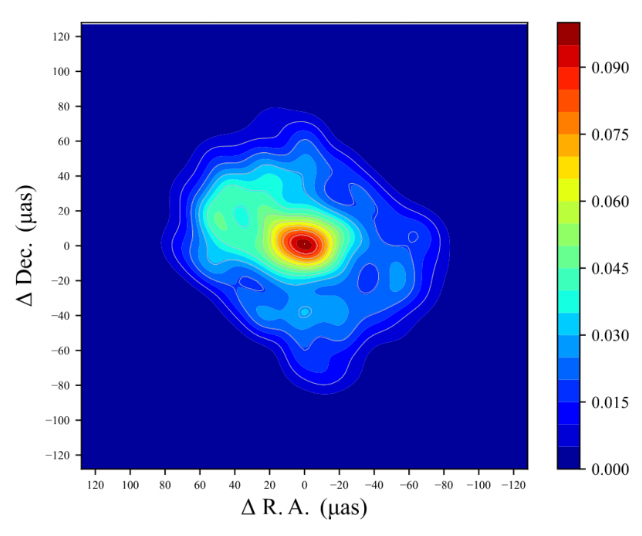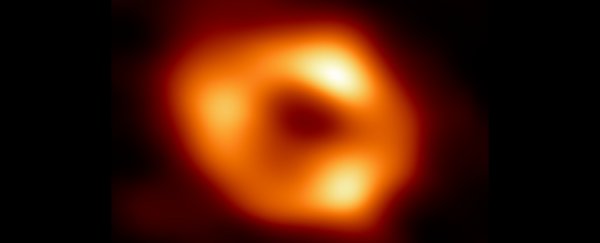Remember that amazing 'first image' of Sagittarius A* (Sgr A) black hole at the heart of the Milky Way? Well, it may not be completely accurate, according to researchers at the National Astronomical Observatory of Japan (NAOJ).
Instead, the accretion disk around Sgr A* may be more elongated, rather than the circular shape we first saw in 2022.
Scientists at NAOJ applied different analysis methods to the data of Sgr A* first taken by the Event Horizon Telescope (EHT) team. The EHT data came from a network of eight ground-based radio telescopes. The original analysis showed a bright ring structure surrounding a dark central region.
The re-analysis resulting in a different shape implies something about the motions and distribution of matter in the disk.
In fairness to both teams, radio interferometry data is notoriously complex to analyze. According to NAOJ astronomer Miyoshi Mikato, the rounded appearance may be due to the way the image was constructed.
"We hypothesize that the ring image resulted from errors during EHT's imaging analysis and that part of it was an artifact, rather than the actual astronomical structure," Miyoshi suggested.

Explaining the black hole appearance
So, what does Sgr A* look like in the NAOJ re-analysis?
"Our image is slightly elongated in the east-west direction, and the eastern half is brighter than the western half," said Miyoshi.
"We think this appearance means the accretion disk surrounding the black hole is rotating at about 60 percent of the speed of light."
The accretion disk is filled with superheated material 'circling the drain' as it were, funneling into the 4-million-solar-mass black hole. As it cycles through the accretion disk, friction and the action of magnetic fields heat the material. That causes it to glow, mostly in x-rays and visible light as well as giving off radio emissions.
Various factors also influence the shape of the accretion disk, including the spin of the black hole itself. In addition, the accretion rate (that is, how much material falls into the disk), as well as the angular momentum of the material, all affect the shape.
The gravitational pull of the black hole also distorts our view of the accretion disk. That sort of 'funhouse mirror' distortion makes it incredibly difficult to image. As it turns out, either view of the disk's actual shape – the original EHT circular view or the NAOJ elongated view – could be accurate.
So, why the different views of the black hole?
How did the teams come up with two slightly different views of Sgr A* using the same data?
"No telescope can capture an astronomical image perfectly," Miyoshi pointed out. For the EHT observations, it turns out that interferometric data from the widely linked telescopes can have gaps. During data analysis, scientists have to use special techniques to construct a complete image. That's what the EHT team did, resulting in the 'round black hole' image.
Miyoshi's team published a paper describing their results. In it, they propose that the ring structure in the 2022 image released by EHT is an artifact caused by the bumpy point-spread function (PSF) of the EHT data.
The PSF describes how an imaging system deals with a point source in the region it's looking at. It helps give a measure of the amount of blurring that occurs because of imperfections in the optics (or in this case, the gaps in the interferometric data). In other words, it had problems with 'filling' in the gaps.
The NAOJ team reanalyzed the data and used a different mapping method to smooth over the gaps in the data. That resulted in an elongated shape for the Sgr A* accretion disk.
One-half of the disk is brighter and they suggest it's due to a Doppler boost as the disk rotates rapidly. They suggest that the newly analyzed data and elongated image shows a portion of the disk that lies a few Schwarzschild radii away from the black hole, rotating extremely fast, and viewed from an angle of 40°-45°.
What's next?
This reanalysis should help contribute to a better understanding of what the Sgr A* accretion disk actually looks like. The EHT study of Sgr A* resulting in the 2022 image release was the first detailed attempt to map the region around the black hole.
The EHT consortium is working on improvements to produce better and more detailed interferometry images of this and other black holes. Eventually, that should result in more accurate views.
Follow-up studies should help fill in any gaps in the observations of the accretion disk. In addition, detailed studies of the near environment around the black hole should give more clues to the black hole hidden inside the disk.
This article was originally published by Universe Today. Read the original article.
